Diploma in Community Services: Advocacy, Crisis, and Support
VerifiedAdded on 2022/10/17
|13
|3753
|187
Homework Assignment
AI Summary
This document provides detailed answers to a Diploma in Community Services assignment, addressing key aspects of advocacy, crisis intervention, and client support. The assignment covers topics such as advocating for clients, both individually and in groups, and the skills required for successful advocacy. It explores how to seek support, form alliances, and assess the success of advocacy efforts, including managing conflicts and maintaining accountability. The document also examines the process of referring clients to other services, coordinating multiple resources, and addressing issues that may arise for clients, their families, and support workers. It further delves into crisis situations, communication strategies for building trust, legal and ethical obligations, and assisting clients in identifying and addressing urgent issues. The assignment also discusses barriers to seeking help, the importance of supervision and debriefing, and client involvement in support plan reviews. Finally, it outlines best practices for client documentation and minimizing risks associated with supporting people in crisis, including identifying indicators of abuse and relevant strategies.
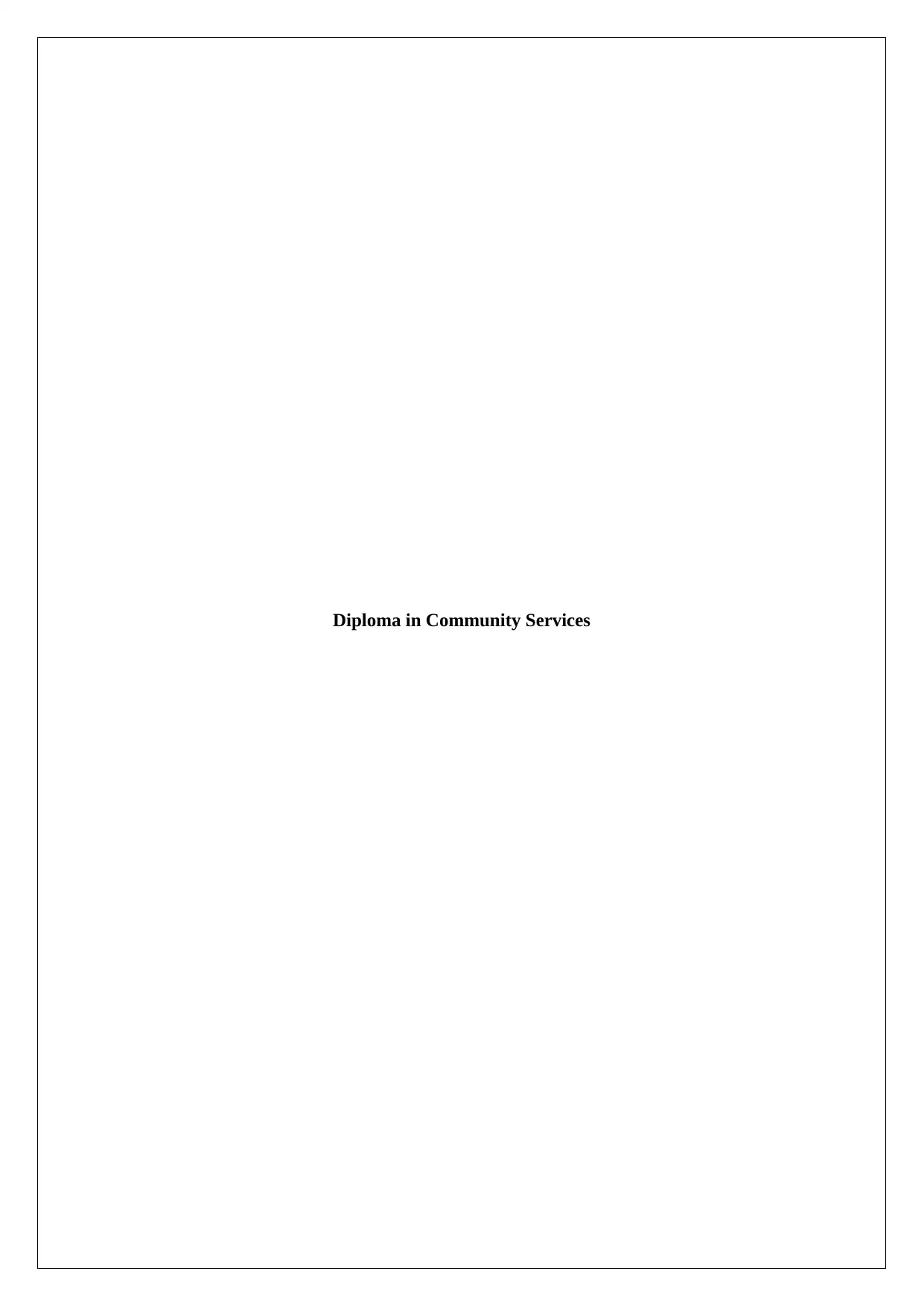
Diploma in Community Services
Paraphrase This Document
Need a fresh take? Get an instant paraphrase of this document with our AI Paraphraser

Contents
Part1...........................................................................................................................................3
Part2...........................................................................................................................................5
Part 3..........................................................................................................................................8
References................................................................................................................................12
Page 2 of 13
Part1...........................................................................................................................................3
Part2...........................................................................................................................................5
Part 3..........................................................................................................................................8
References................................................................................................................................12
Page 2 of 13
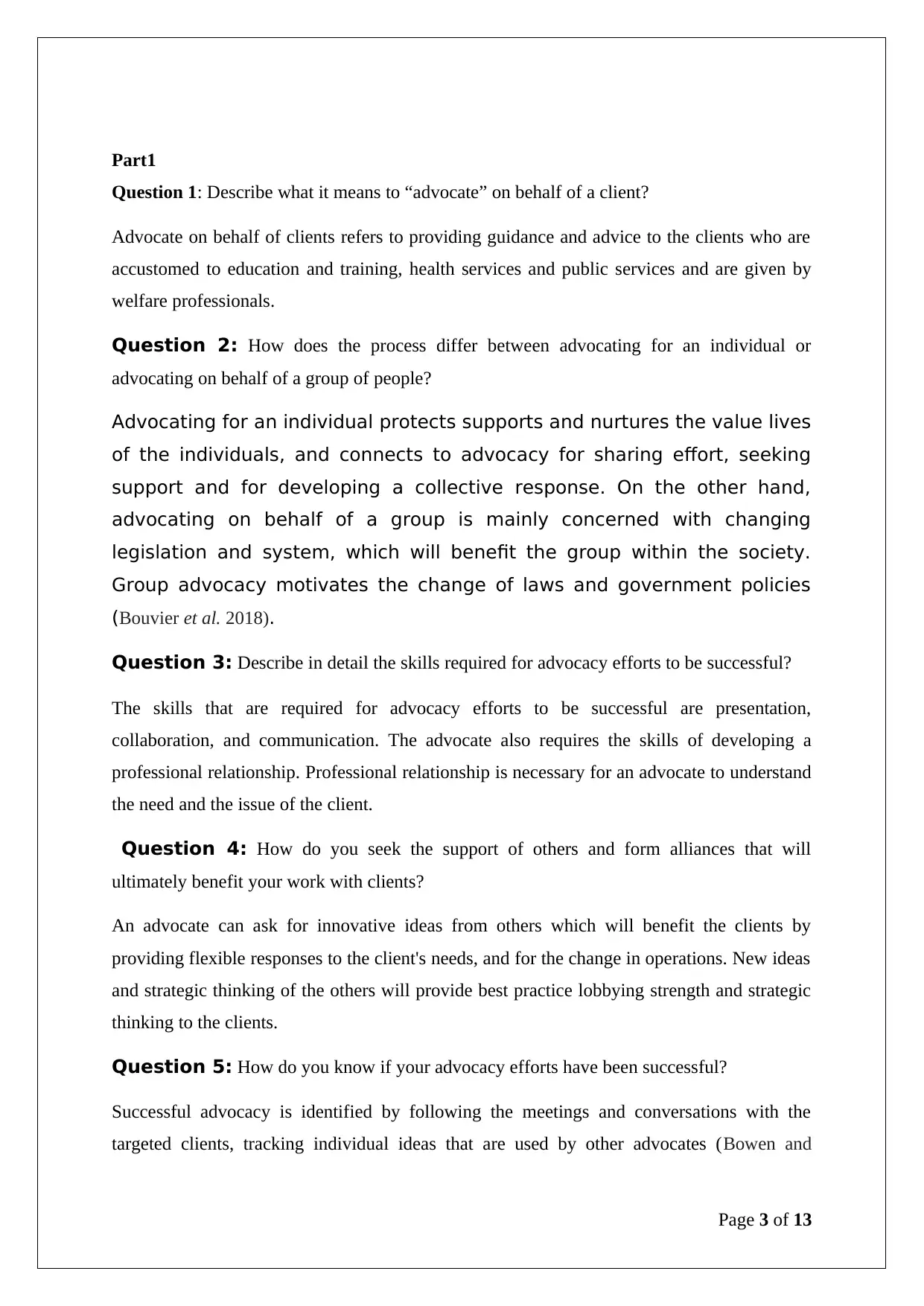
Part1
Question 1: Describe what it means to “advocate” on behalf of a client?
Advocate on behalf of clients refers to providing guidance and advice to the clients who are
accustomed to education and training, health services and public services and are given by
welfare professionals.
Question 2: How does the process differ between advocating for an individual or
advocating on behalf of a group of people?
Advocating for an individual protects supports and nurtures the value lives
of the individuals, and connects to advocacy for sharing effort, seeking
support and for developing a collective response. On the other hand,
advocating on behalf of a group is mainly concerned with changing
legislation and system, which will benefit the group within the society.
Group advocacy motivates the change of laws and government policies
(Bouvier et al. 2018).
Question 3: Describe in detail the skills required for advocacy efforts to be successful?
The skills that are required for advocacy efforts to be successful are presentation,
collaboration, and communication. The advocate also requires the skills of developing a
professional relationship. Professional relationship is necessary for an advocate to understand
the need and the issue of the client.
Question 4: How do you seek the support of others and form alliances that will
ultimately benefit your work with clients?
An advocate can ask for innovative ideas from others which will benefit the clients by
providing flexible responses to the client's needs, and for the change in operations. New ideas
and strategic thinking of the others will provide best practice lobbying strength and strategic
thinking to the clients.
Question 5: How do you know if your advocacy efforts have been successful?
Successful advocacy is identified by following the meetings and conversations with the
targeted clients, tracking individual ideas that are used by other advocates (Bowen and
Page 3 of 13
Question 1: Describe what it means to “advocate” on behalf of a client?
Advocate on behalf of clients refers to providing guidance and advice to the clients who are
accustomed to education and training, health services and public services and are given by
welfare professionals.
Question 2: How does the process differ between advocating for an individual or
advocating on behalf of a group of people?
Advocating for an individual protects supports and nurtures the value lives
of the individuals, and connects to advocacy for sharing effort, seeking
support and for developing a collective response. On the other hand,
advocating on behalf of a group is mainly concerned with changing
legislation and system, which will benefit the group within the society.
Group advocacy motivates the change of laws and government policies
(Bouvier et al. 2018).
Question 3: Describe in detail the skills required for advocacy efforts to be successful?
The skills that are required for advocacy efforts to be successful are presentation,
collaboration, and communication. The advocate also requires the skills of developing a
professional relationship. Professional relationship is necessary for an advocate to understand
the need and the issue of the client.
Question 4: How do you seek the support of others and form alliances that will
ultimately benefit your work with clients?
An advocate can ask for innovative ideas from others which will benefit the clients by
providing flexible responses to the client's needs, and for the change in operations. New ideas
and strategic thinking of the others will provide best practice lobbying strength and strategic
thinking to the clients.
Question 5: How do you know if your advocacy efforts have been successful?
Successful advocacy is identified by following the meetings and conversations with the
targeted clients, tracking individual ideas that are used by other advocates (Bowen and
Page 3 of 13
⊘ This is a preview!⊘
Do you want full access?
Subscribe today to unlock all pages.

Trusted by 1+ million students worldwide
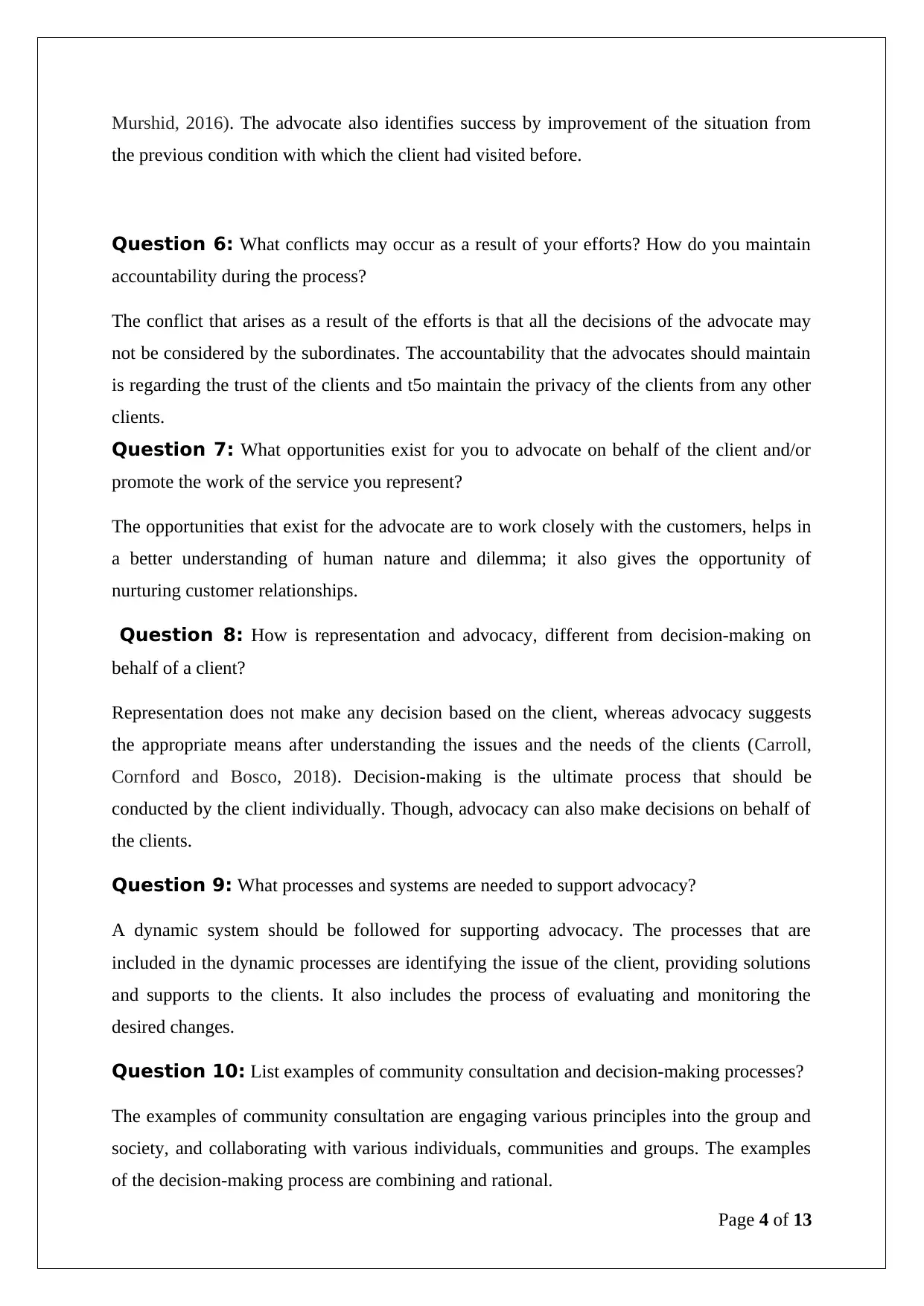
Murshid, 2016). The advocate also identifies success by improvement of the situation from
the previous condition with which the client had visited before.
Question 6: What conflicts may occur as a result of your efforts? How do you maintain
accountability during the process?
The conflict that arises as a result of the efforts is that all the decisions of the advocate may
not be considered by the subordinates. The accountability that the advocates should maintain
is regarding the trust of the clients and t5o maintain the privacy of the clients from any other
clients.
Question 7: What opportunities exist for you to advocate on behalf of the client and/or
promote the work of the service you represent?
The opportunities that exist for the advocate are to work closely with the customers, helps in
a better understanding of human nature and dilemma; it also gives the opportunity of
nurturing customer relationships.
Question 8: How is representation and advocacy, different from decision-making on
behalf of a client?
Representation does not make any decision based on the client, whereas advocacy suggests
the appropriate means after understanding the issues and the needs of the clients (Carroll,
Cornford and Bosco, 2018). Decision-making is the ultimate process that should be
conducted by the client individually. Though, advocacy can also make decisions on behalf of
the clients.
Question 9: What processes and systems are needed to support advocacy?
A dynamic system should be followed for supporting advocacy. The processes that are
included in the dynamic processes are identifying the issue of the client, providing solutions
and supports to the clients. It also includes the process of evaluating and monitoring the
desired changes.
Question 10: List examples of community consultation and decision-making processes?
The examples of community consultation are engaging various principles into the group and
society, and collaborating with various individuals, communities and groups. The examples
of the decision-making process are combining and rational.
Page 4 of 13
the previous condition with which the client had visited before.
Question 6: What conflicts may occur as a result of your efforts? How do you maintain
accountability during the process?
The conflict that arises as a result of the efforts is that all the decisions of the advocate may
not be considered by the subordinates. The accountability that the advocates should maintain
is regarding the trust of the clients and t5o maintain the privacy of the clients from any other
clients.
Question 7: What opportunities exist for you to advocate on behalf of the client and/or
promote the work of the service you represent?
The opportunities that exist for the advocate are to work closely with the customers, helps in
a better understanding of human nature and dilemma; it also gives the opportunity of
nurturing customer relationships.
Question 8: How is representation and advocacy, different from decision-making on
behalf of a client?
Representation does not make any decision based on the client, whereas advocacy suggests
the appropriate means after understanding the issues and the needs of the clients (Carroll,
Cornford and Bosco, 2018). Decision-making is the ultimate process that should be
conducted by the client individually. Though, advocacy can also make decisions on behalf of
the clients.
Question 9: What processes and systems are needed to support advocacy?
A dynamic system should be followed for supporting advocacy. The processes that are
included in the dynamic processes are identifying the issue of the client, providing solutions
and supports to the clients. It also includes the process of evaluating and monitoring the
desired changes.
Question 10: List examples of community consultation and decision-making processes?
The examples of community consultation are engaging various principles into the group and
society, and collaborating with various individuals, communities and groups. The examples
of the decision-making process are combining and rational.
Page 4 of 13
Paraphrase This Document
Need a fresh take? Get an instant paraphrase of this document with our AI Paraphraser
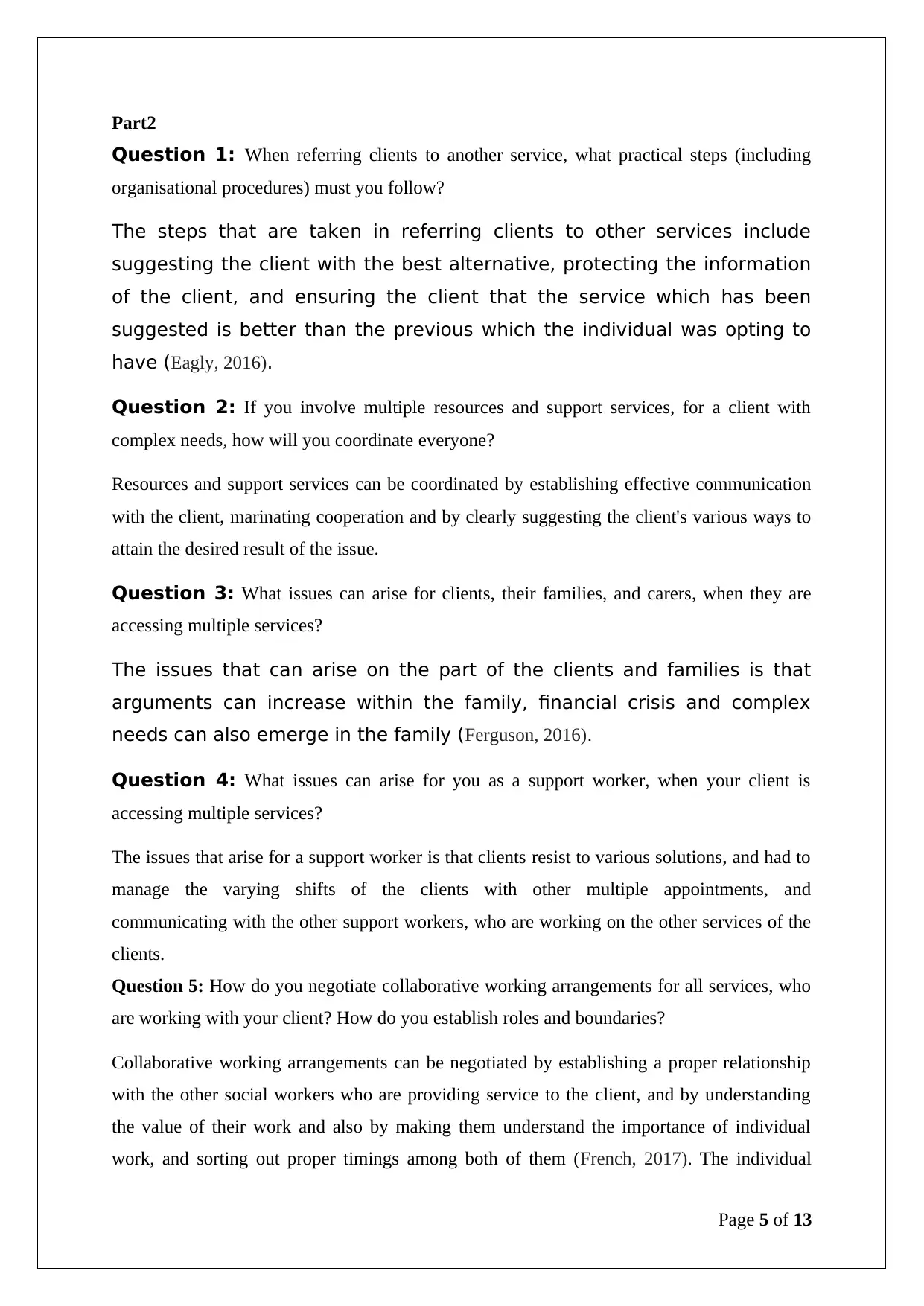
Part2
Question 1: When referring clients to another service, what practical steps (including
organisational procedures) must you follow?
The steps that are taken in referring clients to other services include
suggesting the client with the best alternative, protecting the information
of the client, and ensuring the client that the service which has been
suggested is better than the previous which the individual was opting to
have (Eagly, 2016).
Question 2: If you involve multiple resources and support services, for a client with
complex needs, how will you coordinate everyone?
Resources and support services can be coordinated by establishing effective communication
with the client, marinating cooperation and by clearly suggesting the client's various ways to
attain the desired result of the issue.
Question 3: What issues can arise for clients, their families, and carers, when they are
accessing multiple services?
The issues that can arise on the part of the clients and families is that
arguments can increase within the family, financial crisis and complex
needs can also emerge in the family (Ferguson, 2016).
Question 4: What issues can arise for you as a support worker, when your client is
accessing multiple services?
The issues that arise for a support worker is that clients resist to various solutions, and had to
manage the varying shifts of the clients with other multiple appointments, and
communicating with the other support workers, who are working on the other services of the
clients.
Question 5: How do you negotiate collaborative working arrangements for all services, who
are working with your client? How do you establish roles and boundaries?
Collaborative working arrangements can be negotiated by establishing a proper relationship
with the other social workers who are providing service to the client, and by understanding
the value of their work and also by making them understand the importance of individual
work, and sorting out proper timings among both of them (French, 2017). The individual
Page 5 of 13
Question 1: When referring clients to another service, what practical steps (including
organisational procedures) must you follow?
The steps that are taken in referring clients to other services include
suggesting the client with the best alternative, protecting the information
of the client, and ensuring the client that the service which has been
suggested is better than the previous which the individual was opting to
have (Eagly, 2016).
Question 2: If you involve multiple resources and support services, for a client with
complex needs, how will you coordinate everyone?
Resources and support services can be coordinated by establishing effective communication
with the client, marinating cooperation and by clearly suggesting the client's various ways to
attain the desired result of the issue.
Question 3: What issues can arise for clients, their families, and carers, when they are
accessing multiple services?
The issues that can arise on the part of the clients and families is that
arguments can increase within the family, financial crisis and complex
needs can also emerge in the family (Ferguson, 2016).
Question 4: What issues can arise for you as a support worker, when your client is
accessing multiple services?
The issues that arise for a support worker is that clients resist to various solutions, and had to
manage the varying shifts of the clients with other multiple appointments, and
communicating with the other support workers, who are working on the other services of the
clients.
Question 5: How do you negotiate collaborative working arrangements for all services, who
are working with your client? How do you establish roles and boundaries?
Collaborative working arrangements can be negotiated by establishing a proper relationship
with the other social workers who are providing service to the client, and by understanding
the value of their work and also by making them understand the importance of individual
work, and sorting out proper timings among both of them (French, 2017). The individual
Page 5 of 13
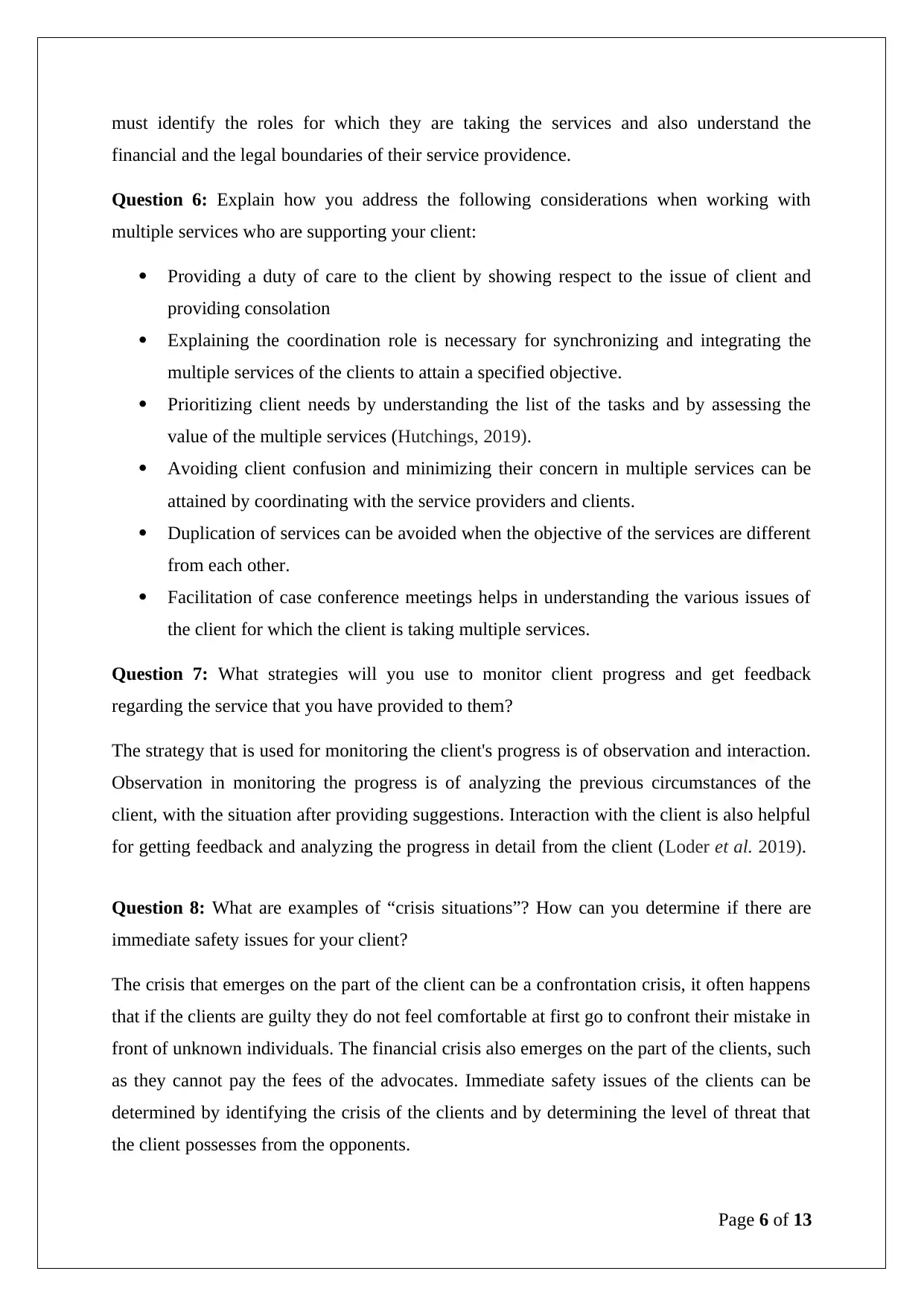
must identify the roles for which they are taking the services and also understand the
financial and the legal boundaries of their service providence.
Question 6: Explain how you address the following considerations when working with
multiple services who are supporting your client:
Providing a duty of care to the client by showing respect to the issue of client and
providing consolation
Explaining the coordination role is necessary for synchronizing and integrating the
multiple services of the clients to attain a specified objective.
Prioritizing client needs by understanding the list of the tasks and by assessing the
value of the multiple services (Hutchings, 2019).
Avoiding client confusion and minimizing their concern in multiple services can be
attained by coordinating with the service providers and clients.
Duplication of services can be avoided when the objective of the services are different
from each other.
Facilitation of case conference meetings helps in understanding the various issues of
the client for which the client is taking multiple services.
Question 7: What strategies will you use to monitor client progress and get feedback
regarding the service that you have provided to them?
The strategy that is used for monitoring the client's progress is of observation and interaction.
Observation in monitoring the progress is of analyzing the previous circumstances of the
client, with the situation after providing suggestions. Interaction with the client is also helpful
for getting feedback and analyzing the progress in detail from the client (Loder et al. 2019).
Question 8: What are examples of “crisis situations”? How can you determine if there are
immediate safety issues for your client?
The crisis that emerges on the part of the client can be a confrontation crisis, it often happens
that if the clients are guilty they do not feel comfortable at first go to confront their mistake in
front of unknown individuals. The financial crisis also emerges on the part of the clients, such
as they cannot pay the fees of the advocates. Immediate safety issues of the clients can be
determined by identifying the crisis of the clients and by determining the level of threat that
the client possesses from the opponents.
Page 6 of 13
financial and the legal boundaries of their service providence.
Question 6: Explain how you address the following considerations when working with
multiple services who are supporting your client:
Providing a duty of care to the client by showing respect to the issue of client and
providing consolation
Explaining the coordination role is necessary for synchronizing and integrating the
multiple services of the clients to attain a specified objective.
Prioritizing client needs by understanding the list of the tasks and by assessing the
value of the multiple services (Hutchings, 2019).
Avoiding client confusion and minimizing their concern in multiple services can be
attained by coordinating with the service providers and clients.
Duplication of services can be avoided when the objective of the services are different
from each other.
Facilitation of case conference meetings helps in understanding the various issues of
the client for which the client is taking multiple services.
Question 7: What strategies will you use to monitor client progress and get feedback
regarding the service that you have provided to them?
The strategy that is used for monitoring the client's progress is of observation and interaction.
Observation in monitoring the progress is of analyzing the previous circumstances of the
client, with the situation after providing suggestions. Interaction with the client is also helpful
for getting feedback and analyzing the progress in detail from the client (Loder et al. 2019).
Question 8: What are examples of “crisis situations”? How can you determine if there are
immediate safety issues for your client?
The crisis that emerges on the part of the client can be a confrontation crisis, it often happens
that if the clients are guilty they do not feel comfortable at first go to confront their mistake in
front of unknown individuals. The financial crisis also emerges on the part of the clients, such
as they cannot pay the fees of the advocates. Immediate safety issues of the clients can be
determined by identifying the crisis of the clients and by determining the level of threat that
the client possesses from the opponents.
Page 6 of 13
⊘ This is a preview!⊘
Do you want full access?
Subscribe today to unlock all pages.

Trusted by 1+ million students worldwide
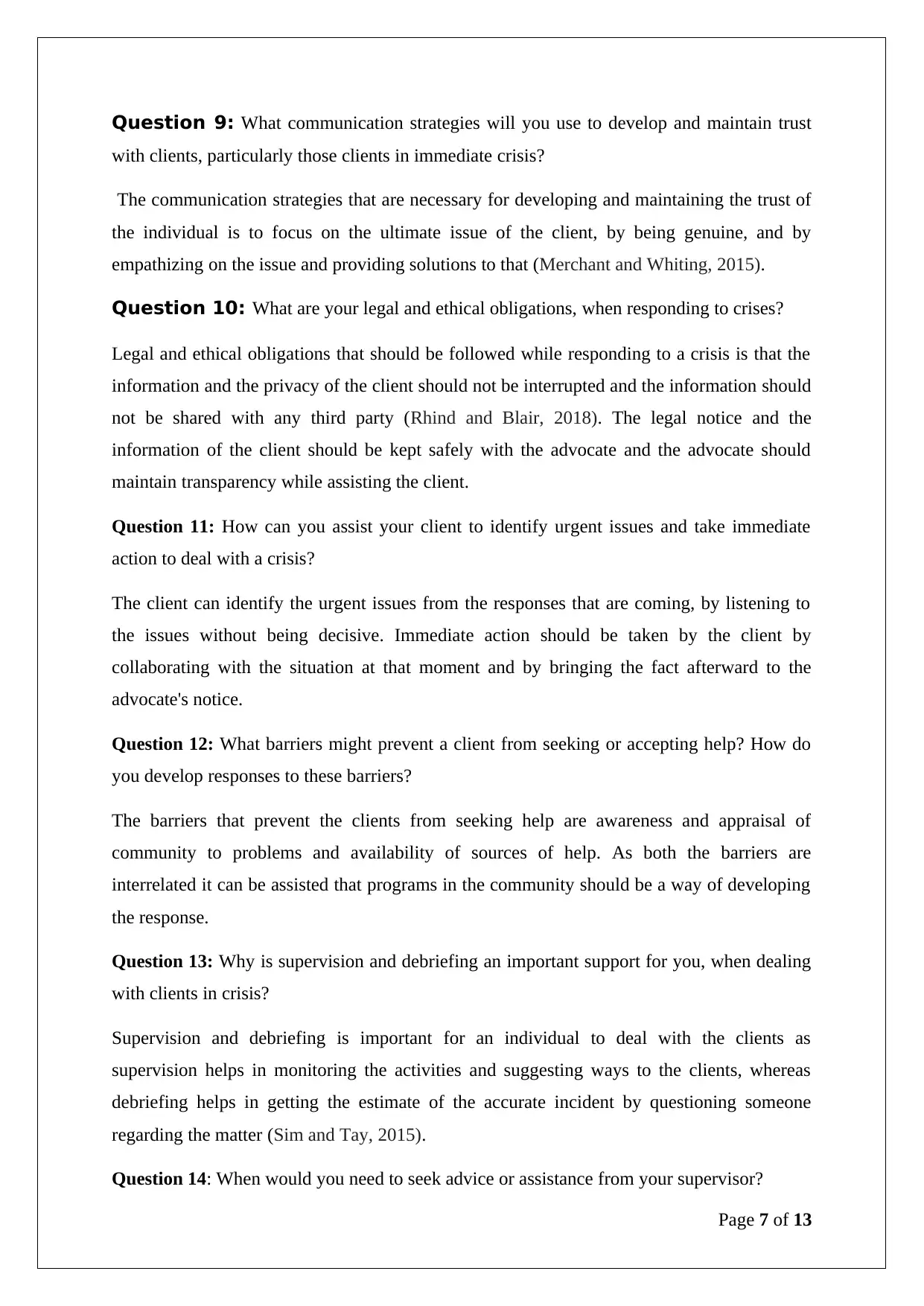
Question 9: What communication strategies will you use to develop and maintain trust
with clients, particularly those clients in immediate crisis?
The communication strategies that are necessary for developing and maintaining the trust of
the individual is to focus on the ultimate issue of the client, by being genuine, and by
empathizing on the issue and providing solutions to that (Merchant and Whiting, 2015).
Question 10: What are your legal and ethical obligations, when responding to crises?
Legal and ethical obligations that should be followed while responding to a crisis is that the
information and the privacy of the client should not be interrupted and the information should
not be shared with any third party (Rhind and Blair, 2018). The legal notice and the
information of the client should be kept safely with the advocate and the advocate should
maintain transparency while assisting the client.
Question 11: How can you assist your client to identify urgent issues and take immediate
action to deal with a crisis?
The client can identify the urgent issues from the responses that are coming, by listening to
the issues without being decisive. Immediate action should be taken by the client by
collaborating with the situation at that moment and by bringing the fact afterward to the
advocate's notice.
Question 12: What barriers might prevent a client from seeking or accepting help? How do
you develop responses to these barriers?
The barriers that prevent the clients from seeking help are awareness and appraisal of
community to problems and availability of sources of help. As both the barriers are
interrelated it can be assisted that programs in the community should be a way of developing
the response.
Question 13: Why is supervision and debriefing an important support for you, when dealing
with clients in crisis?
Supervision and debriefing is important for an individual to deal with the clients as
supervision helps in monitoring the activities and suggesting ways to the clients, whereas
debriefing helps in getting the estimate of the accurate incident by questioning someone
regarding the matter (Sim and Tay, 2015).
Question 14: When would you need to seek advice or assistance from your supervisor?
Page 7 of 13
with clients, particularly those clients in immediate crisis?
The communication strategies that are necessary for developing and maintaining the trust of
the individual is to focus on the ultimate issue of the client, by being genuine, and by
empathizing on the issue and providing solutions to that (Merchant and Whiting, 2015).
Question 10: What are your legal and ethical obligations, when responding to crises?
Legal and ethical obligations that should be followed while responding to a crisis is that the
information and the privacy of the client should not be interrupted and the information should
not be shared with any third party (Rhind and Blair, 2018). The legal notice and the
information of the client should be kept safely with the advocate and the advocate should
maintain transparency while assisting the client.
Question 11: How can you assist your client to identify urgent issues and take immediate
action to deal with a crisis?
The client can identify the urgent issues from the responses that are coming, by listening to
the issues without being decisive. Immediate action should be taken by the client by
collaborating with the situation at that moment and by bringing the fact afterward to the
advocate's notice.
Question 12: What barriers might prevent a client from seeking or accepting help? How do
you develop responses to these barriers?
The barriers that prevent the clients from seeking help are awareness and appraisal of
community to problems and availability of sources of help. As both the barriers are
interrelated it can be assisted that programs in the community should be a way of developing
the response.
Question 13: Why is supervision and debriefing an important support for you, when dealing
with clients in crisis?
Supervision and debriefing is important for an individual to deal with the clients as
supervision helps in monitoring the activities and suggesting ways to the clients, whereas
debriefing helps in getting the estimate of the accurate incident by questioning someone
regarding the matter (Sim and Tay, 2015).
Question 14: When would you need to seek advice or assistance from your supervisor?
Page 7 of 13
Paraphrase This Document
Need a fresh take? Get an instant paraphrase of this document with our AI Paraphraser
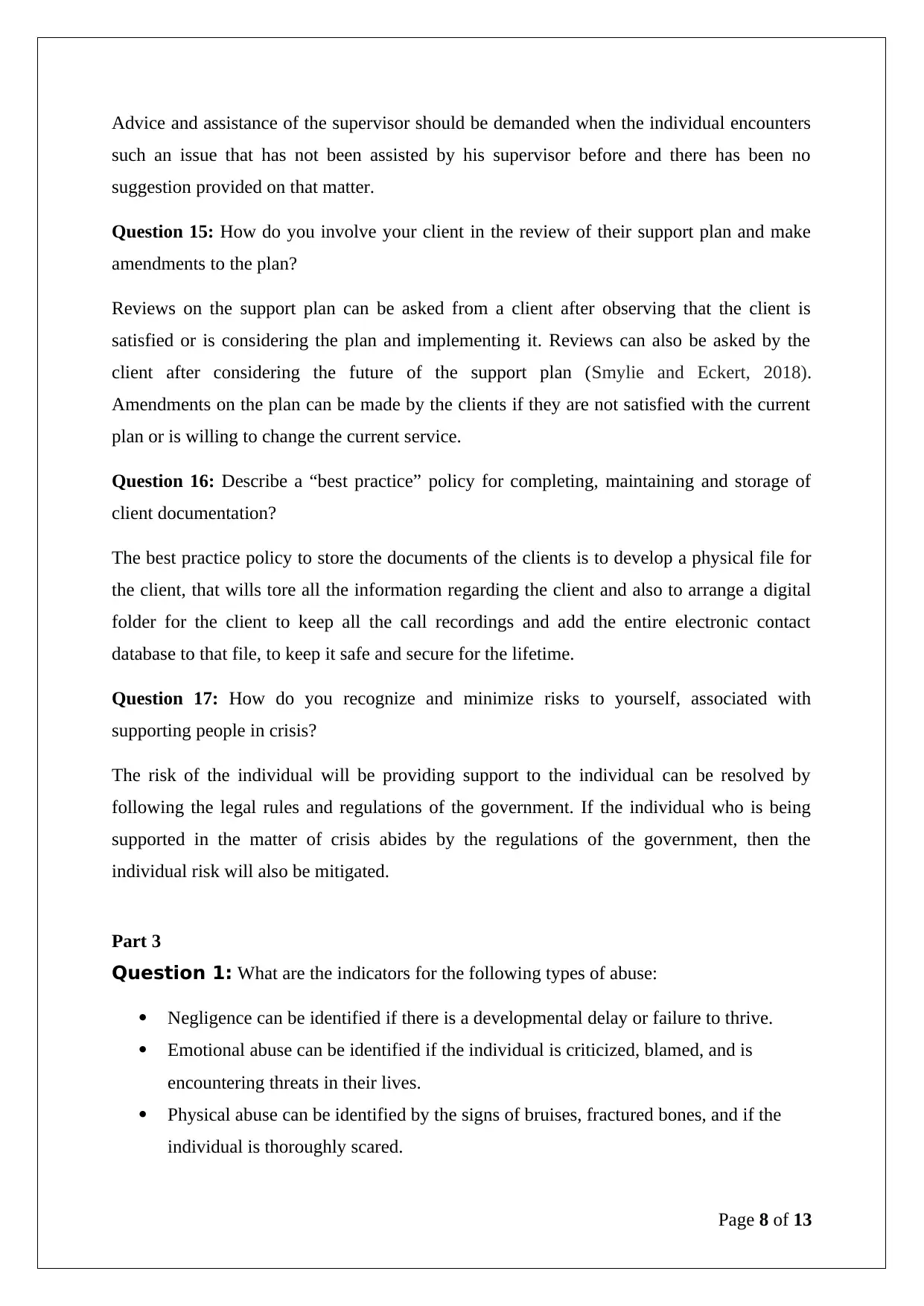
Advice and assistance of the supervisor should be demanded when the individual encounters
such an issue that has not been assisted by his supervisor before and there has been no
suggestion provided on that matter.
Question 15: How do you involve your client in the review of their support plan and make
amendments to the plan?
Reviews on the support plan can be asked from a client after observing that the client is
satisfied or is considering the plan and implementing it. Reviews can also be asked by the
client after considering the future of the support plan (Smylie and Eckert, 2018).
Amendments on the plan can be made by the clients if they are not satisfied with the current
plan or is willing to change the current service.
Question 16: Describe a “best practice” policy for completing, maintaining and storage of
client documentation?
The best practice policy to store the documents of the clients is to develop a physical file for
the client, that wills tore all the information regarding the client and also to arrange a digital
folder for the client to keep all the call recordings and add the entire electronic contact
database to that file, to keep it safe and secure for the lifetime.
Question 17: How do you recognize and minimize risks to yourself, associated with
supporting people in crisis?
The risk of the individual will be providing support to the individual can be resolved by
following the legal rules and regulations of the government. If the individual who is being
supported in the matter of crisis abides by the regulations of the government, then the
individual risk will also be mitigated.
Part 3
Question 1: What are the indicators for the following types of abuse:
Negligence can be identified if there is a developmental delay or failure to thrive.
Emotional abuse can be identified if the individual is criticized, blamed, and is
encountering threats in their lives.
Physical abuse can be identified by the signs of bruises, fractured bones, and if the
individual is thoroughly scared.
Page 8 of 13
such an issue that has not been assisted by his supervisor before and there has been no
suggestion provided on that matter.
Question 15: How do you involve your client in the review of their support plan and make
amendments to the plan?
Reviews on the support plan can be asked from a client after observing that the client is
satisfied or is considering the plan and implementing it. Reviews can also be asked by the
client after considering the future of the support plan (Smylie and Eckert, 2018).
Amendments on the plan can be made by the clients if they are not satisfied with the current
plan or is willing to change the current service.
Question 16: Describe a “best practice” policy for completing, maintaining and storage of
client documentation?
The best practice policy to store the documents of the clients is to develop a physical file for
the client, that wills tore all the information regarding the client and also to arrange a digital
folder for the client to keep all the call recordings and add the entire electronic contact
database to that file, to keep it safe and secure for the lifetime.
Question 17: How do you recognize and minimize risks to yourself, associated with
supporting people in crisis?
The risk of the individual will be providing support to the individual can be resolved by
following the legal rules and regulations of the government. If the individual who is being
supported in the matter of crisis abides by the regulations of the government, then the
individual risk will also be mitigated.
Part 3
Question 1: What are the indicators for the following types of abuse:
Negligence can be identified if there is a developmental delay or failure to thrive.
Emotional abuse can be identified if the individual is criticized, blamed, and is
encountering threats in their lives.
Physical abuse can be identified by the signs of bruises, fractured bones, and if the
individual is thoroughly scared.
Page 8 of 13
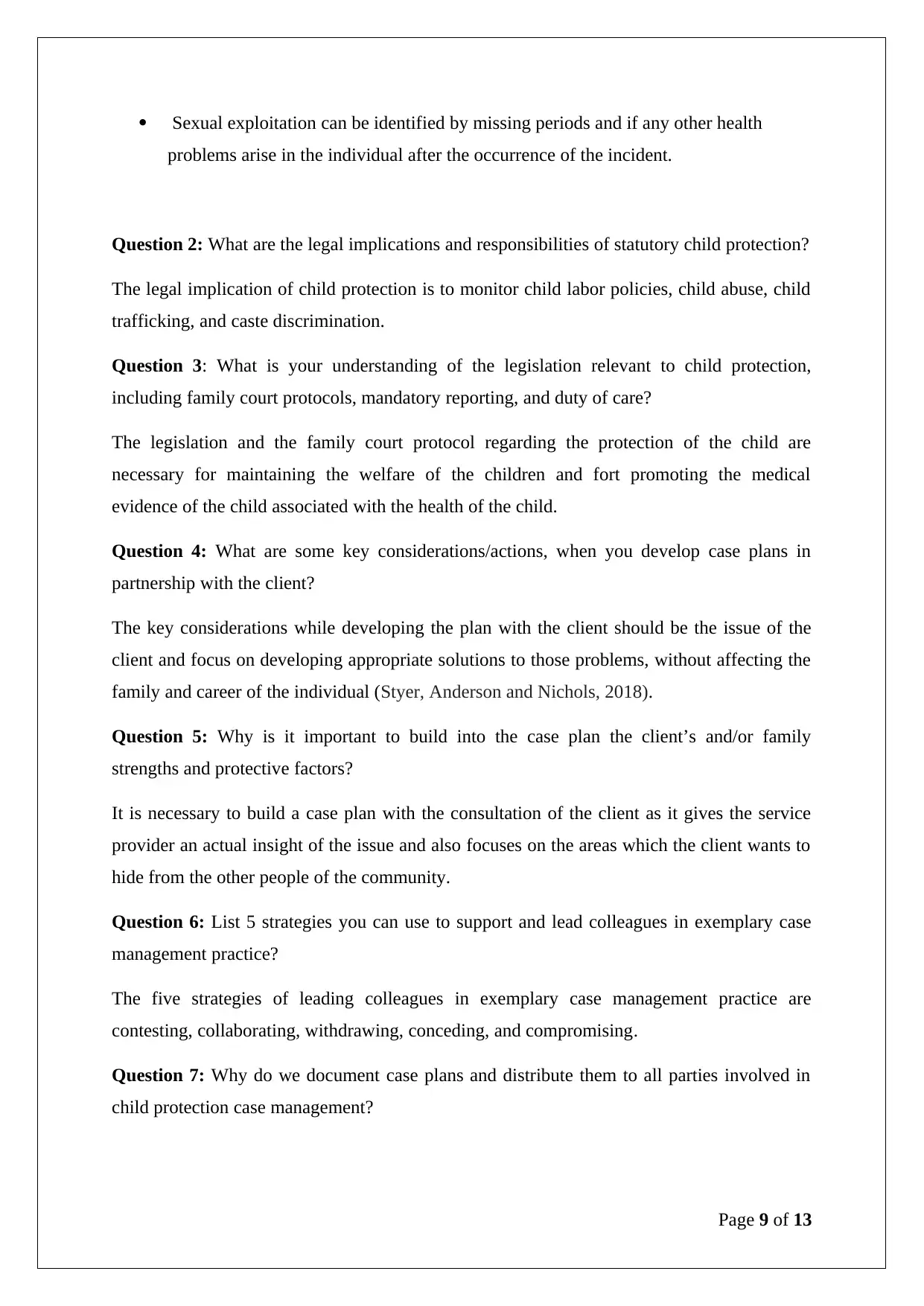
Sexual exploitation can be identified by missing periods and if any other health
problems arise in the individual after the occurrence of the incident.
Question 2: What are the legal implications and responsibilities of statutory child protection?
The legal implication of child protection is to monitor child labor policies, child abuse, child
trafficking, and caste discrimination.
Question 3: What is your understanding of the legislation relevant to child protection,
including family court protocols, mandatory reporting, and duty of care?
The legislation and the family court protocol regarding the protection of the child are
necessary for maintaining the welfare of the children and fort promoting the medical
evidence of the child associated with the health of the child.
Question 4: What are some key considerations/actions, when you develop case plans in
partnership with the client?
The key considerations while developing the plan with the client should be the issue of the
client and focus on developing appropriate solutions to those problems, without affecting the
family and career of the individual (Styer, Anderson and Nichols, 2018).
Question 5: Why is it important to build into the case plan the client’s and/or family
strengths and protective factors?
It is necessary to build a case plan with the consultation of the client as it gives the service
provider an actual insight of the issue and also focuses on the areas which the client wants to
hide from the other people of the community.
Question 6: List 5 strategies you can use to support and lead colleagues in exemplary case
management practice?
The five strategies of leading colleagues in exemplary case management practice are
contesting, collaborating, withdrawing, conceding, and compromising.
Question 7: Why do we document case plans and distribute them to all parties involved in
child protection case management?
Page 9 of 13
problems arise in the individual after the occurrence of the incident.
Question 2: What are the legal implications and responsibilities of statutory child protection?
The legal implication of child protection is to monitor child labor policies, child abuse, child
trafficking, and caste discrimination.
Question 3: What is your understanding of the legislation relevant to child protection,
including family court protocols, mandatory reporting, and duty of care?
The legislation and the family court protocol regarding the protection of the child are
necessary for maintaining the welfare of the children and fort promoting the medical
evidence of the child associated with the health of the child.
Question 4: What are some key considerations/actions, when you develop case plans in
partnership with the client?
The key considerations while developing the plan with the client should be the issue of the
client and focus on developing appropriate solutions to those problems, without affecting the
family and career of the individual (Styer, Anderson and Nichols, 2018).
Question 5: Why is it important to build into the case plan the client’s and/or family
strengths and protective factors?
It is necessary to build a case plan with the consultation of the client as it gives the service
provider an actual insight of the issue and also focuses on the areas which the client wants to
hide from the other people of the community.
Question 6: List 5 strategies you can use to support and lead colleagues in exemplary case
management practice?
The five strategies of leading colleagues in exemplary case management practice are
contesting, collaborating, withdrawing, conceding, and compromising.
Question 7: Why do we document case plans and distribute them to all parties involved in
child protection case management?
Page 9 of 13
⊘ This is a preview!⊘
Do you want full access?
Subscribe today to unlock all pages.

Trusted by 1+ million students worldwide
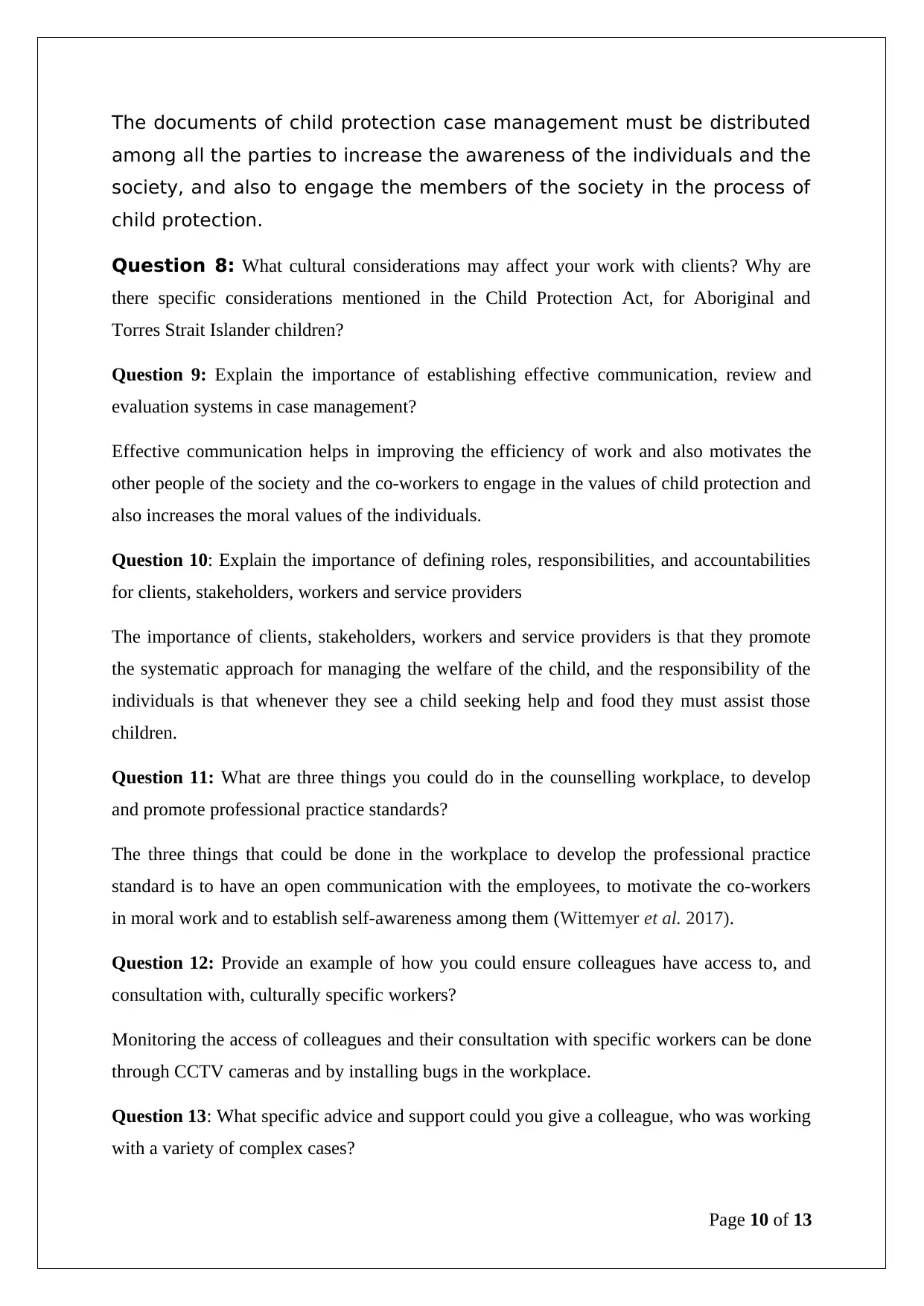
The documents of child protection case management must be distributed
among all the parties to increase the awareness of the individuals and the
society, and also to engage the members of the society in the process of
child protection.
Question 8: What cultural considerations may affect your work with clients? Why are
there specific considerations mentioned in the Child Protection Act, for Aboriginal and
Torres Strait Islander children?
Question 9: Explain the importance of establishing effective communication, review and
evaluation systems in case management?
Effective communication helps in improving the efficiency of work and also motivates the
other people of the society and the co-workers to engage in the values of child protection and
also increases the moral values of the individuals.
Question 10: Explain the importance of defining roles, responsibilities, and accountabilities
for clients, stakeholders, workers and service providers
The importance of clients, stakeholders, workers and service providers is that they promote
the systematic approach for managing the welfare of the child, and the responsibility of the
individuals is that whenever they see a child seeking help and food they must assist those
children.
Question 11: What are three things you could do in the counselling workplace, to develop
and promote professional practice standards?
The three things that could be done in the workplace to develop the professional practice
standard is to have an open communication with the employees, to motivate the co-workers
in moral work and to establish self-awareness among them (Wittemyer et al. 2017).
Question 12: Provide an example of how you could ensure colleagues have access to, and
consultation with, culturally specific workers?
Monitoring the access of colleagues and their consultation with specific workers can be done
through CCTV cameras and by installing bugs in the workplace.
Question 13: What specific advice and support could you give a colleague, who was working
with a variety of complex cases?
Page 10 of 13
among all the parties to increase the awareness of the individuals and the
society, and also to engage the members of the society in the process of
child protection.
Question 8: What cultural considerations may affect your work with clients? Why are
there specific considerations mentioned in the Child Protection Act, for Aboriginal and
Torres Strait Islander children?
Question 9: Explain the importance of establishing effective communication, review and
evaluation systems in case management?
Effective communication helps in improving the efficiency of work and also motivates the
other people of the society and the co-workers to engage in the values of child protection and
also increases the moral values of the individuals.
Question 10: Explain the importance of defining roles, responsibilities, and accountabilities
for clients, stakeholders, workers and service providers
The importance of clients, stakeholders, workers and service providers is that they promote
the systematic approach for managing the welfare of the child, and the responsibility of the
individuals is that whenever they see a child seeking help and food they must assist those
children.
Question 11: What are three things you could do in the counselling workplace, to develop
and promote professional practice standards?
The three things that could be done in the workplace to develop the professional practice
standard is to have an open communication with the employees, to motivate the co-workers
in moral work and to establish self-awareness among them (Wittemyer et al. 2017).
Question 12: Provide an example of how you could ensure colleagues have access to, and
consultation with, culturally specific workers?
Monitoring the access of colleagues and their consultation with specific workers can be done
through CCTV cameras and by installing bugs in the workplace.
Question 13: What specific advice and support could you give a colleague, who was working
with a variety of complex cases?
Page 10 of 13
Paraphrase This Document
Need a fresh take? Get an instant paraphrase of this document with our AI Paraphraser
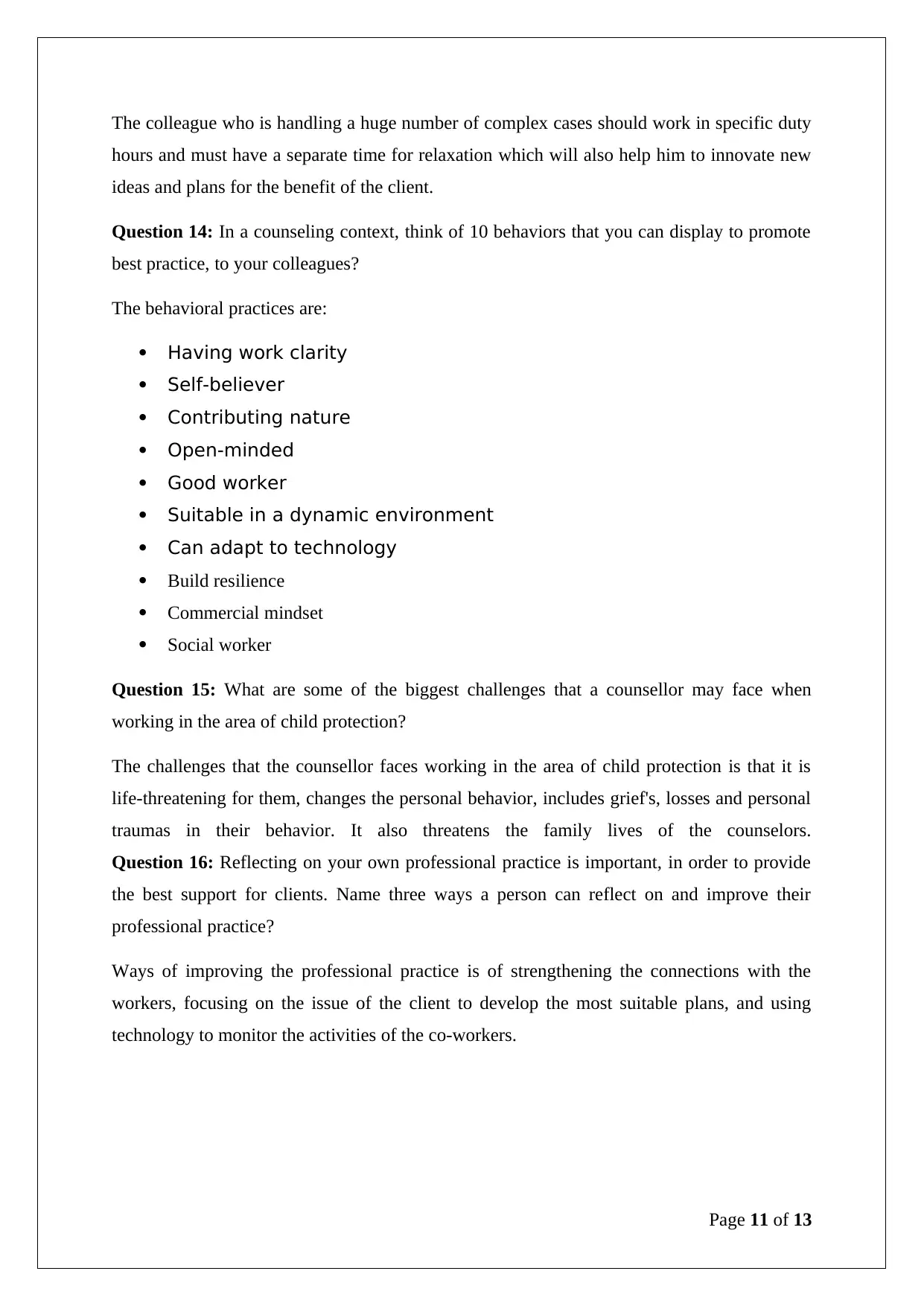
The colleague who is handling a huge number of complex cases should work in specific duty
hours and must have a separate time for relaxation which will also help him to innovate new
ideas and plans for the benefit of the client.
Question 14: In a counseling context, think of 10 behaviors that you can display to promote
best practice, to your colleagues?
The behavioral practices are:
Having work clarity
Self-believer
Contributing nature
Open-minded
Good worker
Suitable in a dynamic environment
Can adapt to technology
Build resilience
Commercial mindset
Social worker
Question 15: What are some of the biggest challenges that a counsellor may face when
working in the area of child protection?
The challenges that the counsellor faces working in the area of child protection is that it is
life-threatening for them, changes the personal behavior, includes grief's, losses and personal
traumas in their behavior. It also threatens the family lives of the counselors.
Question 16: Reflecting on your own professional practice is important, in order to provide
the best support for clients. Name three ways a person can reflect on and improve their
professional practice?
Ways of improving the professional practice is of strengthening the connections with the
workers, focusing on the issue of the client to develop the most suitable plans, and using
technology to monitor the activities of the co-workers.
Page 11 of 13
hours and must have a separate time for relaxation which will also help him to innovate new
ideas and plans for the benefit of the client.
Question 14: In a counseling context, think of 10 behaviors that you can display to promote
best practice, to your colleagues?
The behavioral practices are:
Having work clarity
Self-believer
Contributing nature
Open-minded
Good worker
Suitable in a dynamic environment
Can adapt to technology
Build resilience
Commercial mindset
Social worker
Question 15: What are some of the biggest challenges that a counsellor may face when
working in the area of child protection?
The challenges that the counsellor faces working in the area of child protection is that it is
life-threatening for them, changes the personal behavior, includes grief's, losses and personal
traumas in their behavior. It also threatens the family lives of the counselors.
Question 16: Reflecting on your own professional practice is important, in order to provide
the best support for clients. Name three ways a person can reflect on and improve their
professional practice?
Ways of improving the professional practice is of strengthening the connections with the
workers, focusing on the issue of the client to develop the most suitable plans, and using
technology to monitor the activities of the co-workers.
Page 11 of 13
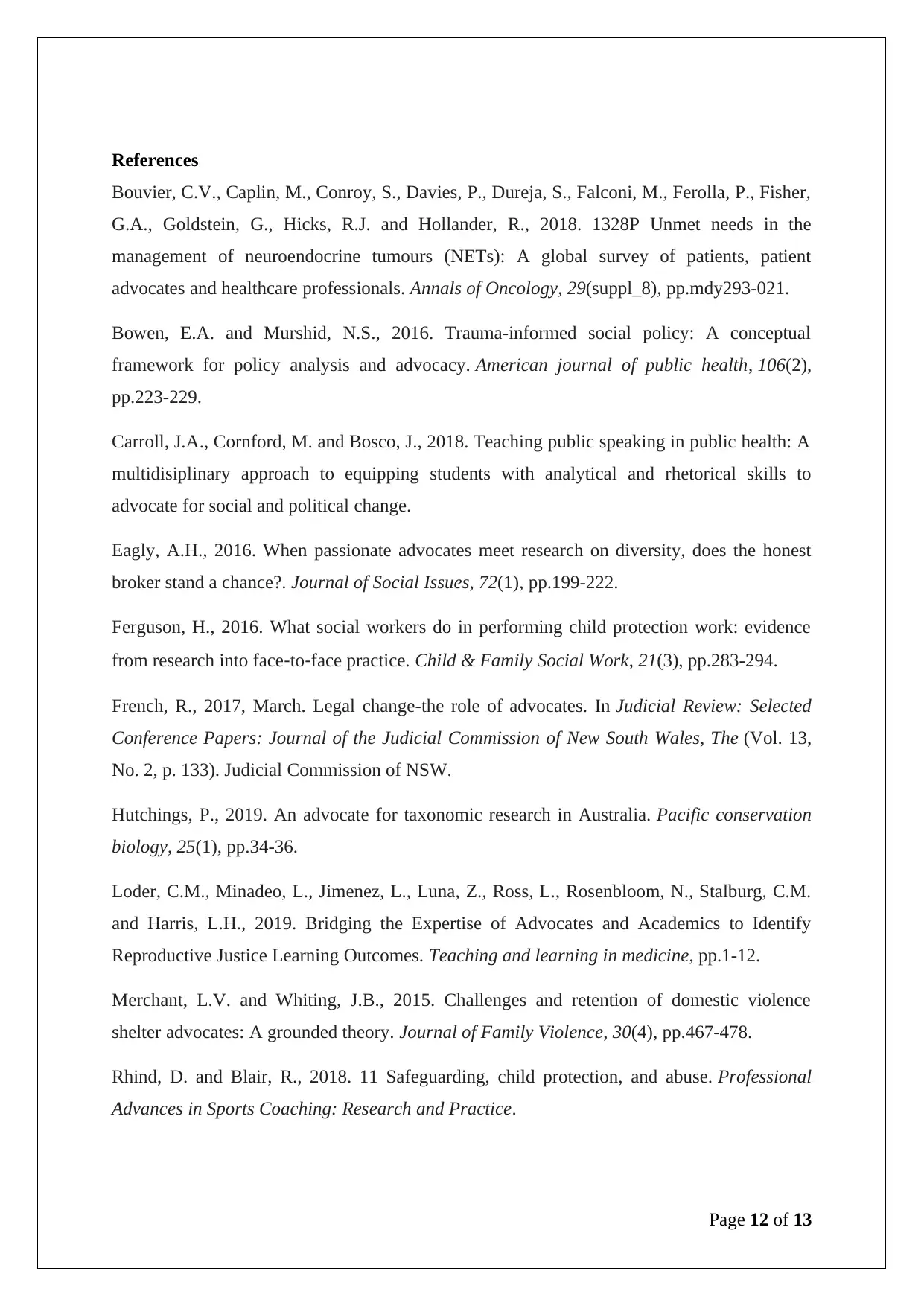
References
Bouvier, C.V., Caplin, M., Conroy, S., Davies, P., Dureja, S., Falconi, M., Ferolla, P., Fisher,
G.A., Goldstein, G., Hicks, R.J. and Hollander, R., 2018. 1328P Unmet needs in the
management of neuroendocrine tumours (NETs): A global survey of patients, patient
advocates and healthcare professionals. Annals of Oncology, 29(suppl_8), pp.mdy293-021.
Bowen, E.A. and Murshid, N.S., 2016. Trauma-informed social policy: A conceptual
framework for policy analysis and advocacy. American journal of public health, 106(2),
pp.223-229.
Carroll, J.A., Cornford, M. and Bosco, J., 2018. Teaching public speaking in public health: A
multidisiplinary approach to equipping students with analytical and rhetorical skills to
advocate for social and political change.
Eagly, A.H., 2016. When passionate advocates meet research on diversity, does the honest
broker stand a chance?. Journal of Social Issues, 72(1), pp.199-222.
Ferguson, H., 2016. What social workers do in performing child protection work: evidence
from research into face‐to‐face practice. Child & Family Social Work, 21(3), pp.283-294.
French, R., 2017, March. Legal change-the role of advocates. In Judicial Review: Selected
Conference Papers: Journal of the Judicial Commission of New South Wales, The (Vol. 13,
No. 2, p. 133). Judicial Commission of NSW.
Hutchings, P., 2019. An advocate for taxonomic research in Australia. Pacific conservation
biology, 25(1), pp.34-36.
Loder, C.M., Minadeo, L., Jimenez, L., Luna, Z., Ross, L., Rosenbloom, N., Stalburg, C.M.
and Harris, L.H., 2019. Bridging the Expertise of Advocates and Academics to Identify
Reproductive Justice Learning Outcomes. Teaching and learning in medicine, pp.1-12.
Merchant, L.V. and Whiting, J.B., 2015. Challenges and retention of domestic violence
shelter advocates: A grounded theory. Journal of Family Violence, 30(4), pp.467-478.
Rhind, D. and Blair, R., 2018. 11 Safeguarding, child protection, and abuse. Professional
Advances in Sports Coaching: Research and Practice.
Page 12 of 13
Bouvier, C.V., Caplin, M., Conroy, S., Davies, P., Dureja, S., Falconi, M., Ferolla, P., Fisher,
G.A., Goldstein, G., Hicks, R.J. and Hollander, R., 2018. 1328P Unmet needs in the
management of neuroendocrine tumours (NETs): A global survey of patients, patient
advocates and healthcare professionals. Annals of Oncology, 29(suppl_8), pp.mdy293-021.
Bowen, E.A. and Murshid, N.S., 2016. Trauma-informed social policy: A conceptual
framework for policy analysis and advocacy. American journal of public health, 106(2),
pp.223-229.
Carroll, J.A., Cornford, M. and Bosco, J., 2018. Teaching public speaking in public health: A
multidisiplinary approach to equipping students with analytical and rhetorical skills to
advocate for social and political change.
Eagly, A.H., 2016. When passionate advocates meet research on diversity, does the honest
broker stand a chance?. Journal of Social Issues, 72(1), pp.199-222.
Ferguson, H., 2016. What social workers do in performing child protection work: evidence
from research into face‐to‐face practice. Child & Family Social Work, 21(3), pp.283-294.
French, R., 2017, March. Legal change-the role of advocates. In Judicial Review: Selected
Conference Papers: Journal of the Judicial Commission of New South Wales, The (Vol. 13,
No. 2, p. 133). Judicial Commission of NSW.
Hutchings, P., 2019. An advocate for taxonomic research in Australia. Pacific conservation
biology, 25(1), pp.34-36.
Loder, C.M., Minadeo, L., Jimenez, L., Luna, Z., Ross, L., Rosenbloom, N., Stalburg, C.M.
and Harris, L.H., 2019. Bridging the Expertise of Advocates and Academics to Identify
Reproductive Justice Learning Outcomes. Teaching and learning in medicine, pp.1-12.
Merchant, L.V. and Whiting, J.B., 2015. Challenges and retention of domestic violence
shelter advocates: A grounded theory. Journal of Family Violence, 30(4), pp.467-478.
Rhind, D. and Blair, R., 2018. 11 Safeguarding, child protection, and abuse. Professional
Advances in Sports Coaching: Research and Practice.
Page 12 of 13
⊘ This is a preview!⊘
Do you want full access?
Subscribe today to unlock all pages.

Trusted by 1+ million students worldwide
1 out of 13
Related Documents
Your All-in-One AI-Powered Toolkit for Academic Success.
+13062052269
info@desklib.com
Available 24*7 on WhatsApp / Email
![[object Object]](/_next/static/media/star-bottom.7253800d.svg)
Unlock your academic potential
Copyright © 2020–2025 A2Z Services. All Rights Reserved. Developed and managed by ZUCOL.





